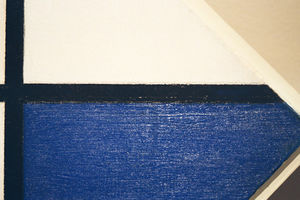User:Chen Junyu/Graduation Project Seminar/ project proposal/Proposal5: Difference between revisions
Chen Junyu (talk | contribs) |
Chen Junyu (talk | contribs) |
||
| (2 intermediate revisions by the same user not shown) | |||
| Line 29: | Line 29: | ||
==Research Question== | ==Research Question== | ||
My research question is, How to most effectively present ( and preserve) | My research question is, How to most effectively present ( and preserve) the vitality of the process of drawing, (here vitality can be related to Hsieh Ho's first principle of Chinese painting: the resonance of the spirit,the vitality.) | ||
==Prototypes== | ==Prototypes== | ||
{{Youtube|1bWy5vd7OwE}} | |||
==Preview works== | ==Preview works== | ||
"How to Draw a Perfect Circle" | "How to Draw a Perfect Circle" | ||
This project is also talking about what is the process of drawing means to us, and also using the fundamental gesture to express it . | |||
<br>{{vimeo|116489227|centre}}<br> | <br>{{vimeo|116489227|centre}}<br> | ||
Latest revision as of 09:20, 10 February 2015
Context
People have found examples of attempts to capture the phenomenon of motion into a still drawing in paleolithic cave painting. The animals in the paintings are usually have multiple legs in superimposed positions to convey the perception of dynamic. The paleolithic cave painting reflect the ancients’ understanding of motion and the desire of recording movement, in addition, it may also hint the consciousness of drawing things lively.
The generally accepted principle for Chinese painting was written by Hsieh Ho,a writer, art historian and critic in 6th century China, named as The Six Principles of Hsieh Ho. He summarized six sentences to divide the different level of paintings. There are different versions of the interpretation in English of the six principles, and all of them are so contrasting, here I use the translation of Osvald Siren's Early Chinese Painting, which I think it is the closest one to the original version.
The six principles of Chinese painting: 1) Resonance of the spirit; Movement of Life.
2) Bone Manner (i.e. Structural) Use of the Brush.
3) Conform with the objects ( to obtain ) their Likeness.
4) According to the Species, apply the Colours.
5) Plan and Design; Place and Position ( Composition)
6) To transmit Models by Drawing.
Hsieh Ho points out the “Spirit Resonance” or vitality is the overall energy of a work of art. It means that the lively representation either or both on depicting concrete objects or conveying the spirit of painter and generally a successful drawing should be able to transfer the dynamic atmosphere to the spectators.
"This quality of underlying movement is, of course, the special 'charm' of drawing which can never properly be carried over from drawing into a finished work of painting or sculpture."(Philip Rawson, Drawing). It is barely possible for spectators experiencing the "charm" of the dynamic and irreversible process from the final work. The "dynamic" of drawing seems obscure and unreadable. "In appreciating drawings, no less than in making them, one has to be continuously aware of the character and qualities of the sequences which went into their composition. To get it at least one has to look into the drawing carefully to find the order in which its parts were executed...But for thoroughgoing preservation of the qualities of drawing in painting one has to look to the Far East --or to Western 'action' painting based on Far Eastern ideas.” Based on his thought, I started thinking how to use Eastern material or at least as a starting point to experiment how to express the "charm" in the process of drawing.
In James Elkins's article How to look at Mondrian, he takes example of Mondrian's work "Lozenge" to explain how Mondrian deal with the lines in his painting. By using macro lense, his observation leads to the result -- those vertical and horizontal lines, are not perfect and smooth lines as we usually think. While Mondrian doing his work, sometimes he may only use his hands without any support, to get the subtle shake or waggle presented on his painting.
Another example is from Paul Klee, his catchphrase "Taking a line for a walk" seems explain the reason of Mondrian's delicate shaking lines. Quoted from "It's a very fine line" by Laura Cumming, "balancing and orchestrating lines so that they take the eye for a walk through fields of graphic energy."
Research Question
My research question is, How to most effectively present ( and preserve) the vitality of the process of drawing, (here vitality can be related to Hsieh Ho's first principle of Chinese painting: the resonance of the spirit,the vitality.)
Prototypes
Preview works
"How to Draw a Perfect Circle"
This project is also talking about what is the process of drawing means to us, and also using the fundamental gesture to express it .
Work Survey
Barry Le Va's On Center, On Edge Shatter Scatter (1968)
Gary Kuehn Gesture Project 2011
These two works both interpret "the process" of their work in a visible and obvious way.
Literature Survey
Philip Rawson, Drawing
Fritz van Briessen, The Way of the Brush: Painting Techniques of China and Japan
James Elkins, Chinese Landscape Painting as Western Art History
Xie He Six principles of Chinese painting 古画品录
Lu Hong, The Formation and Development of New Ink Art in China http://www.mplusmatters.hk/inkart/paper_topic2.php?l=en
Zhu Qi, "Natural and abstract form and the unfinished modernism of Chinese painting" http://www.artlinkart.com/cn/article/overview/b55cvCso
Zong baihua,"Thoughts of <A New Account of the Tales of the World> and the beauty of Jin Dynasty"

